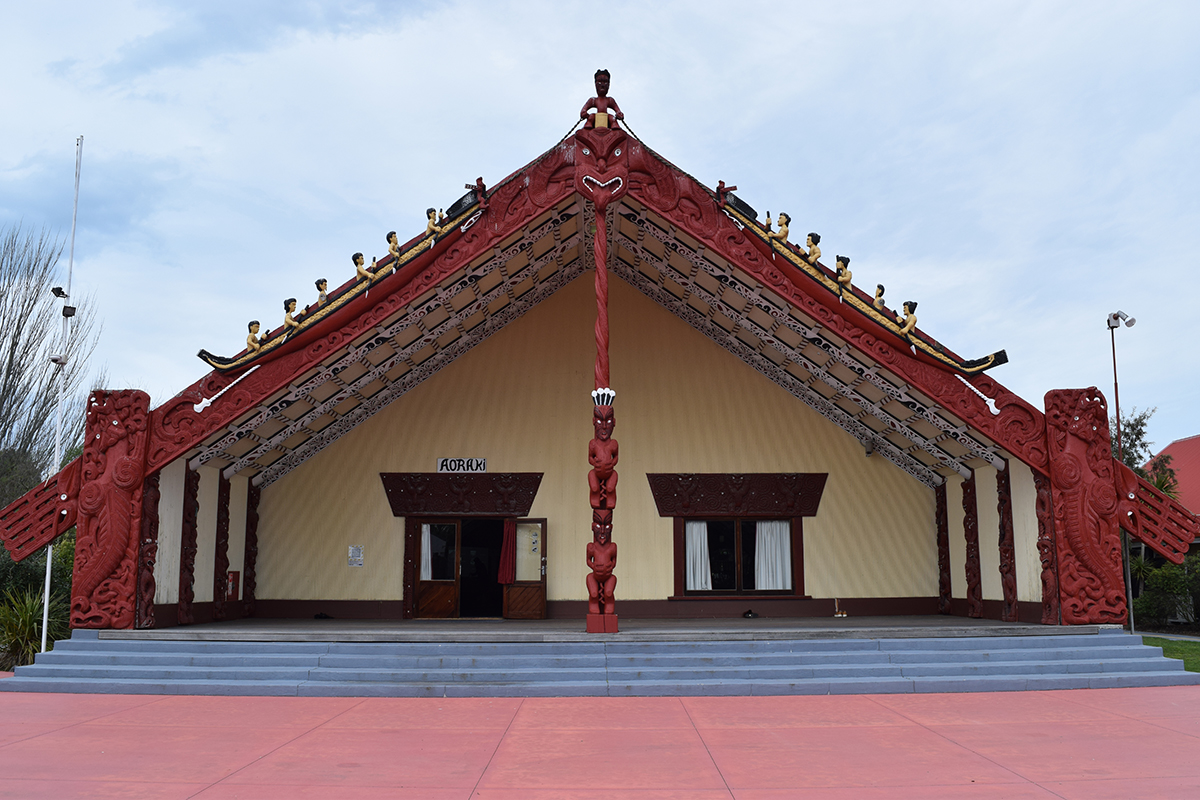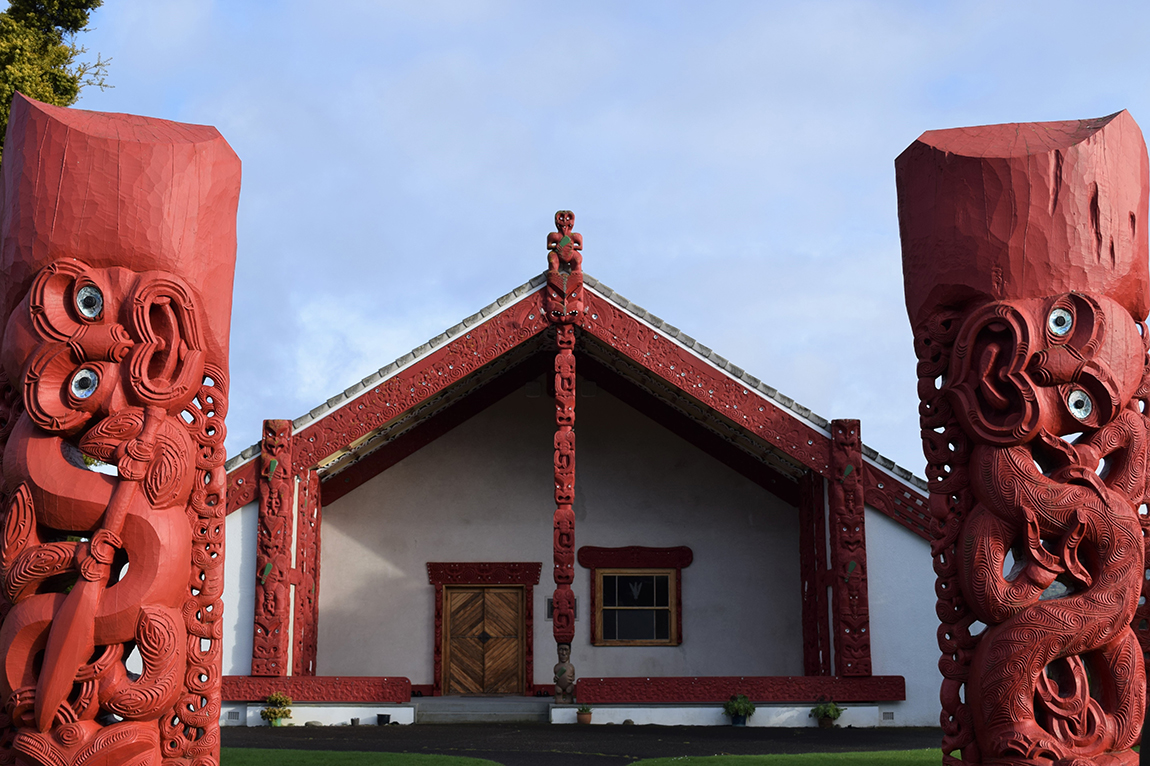Wāhine and tāne in traditional Māori society: roles and relationships
Ko te tāne me te wahine i te hapori Māori o mua: ō rāua tūranga, ō rāua whakapapa anō hoki
Witnesses said the relationship between men and women in traditional Māori society was characterised by balance, equality, and complementarity. Roles were not rigidly defined; both genders could cross into each other’s roles, though some tasks were gender specific. Women were central to bringing together the spiritual and physical realms in various aspects of tikanga. They were life-givers, nurturing children, and maintaining ahi kā, while men more commonly took on roles like hunting, hard labour, and protecting territorial boundaries. However, wāhine influence also extended beyond domestic spheres; they also engaged in protecting land and people. Witnesses emphasised the overall survival of hapū and whānau depended on both genders contributing to collective well-being.
- See what key witnesses said about wāhine and tāne roles and relationships
- See whakataukī
- See key quotes from witnesses
See what witnesses said about the relationship between wāhine and tāne in the contexts of:
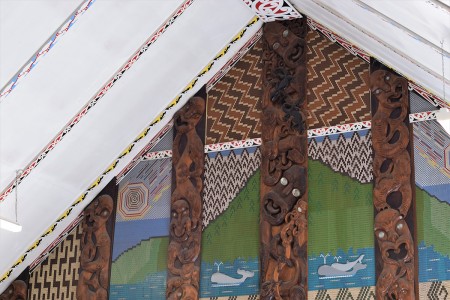
Balance of whakairo (carving) and tukutuku (woven panels) inside Terenga Parāoa Marae
Key witnesses who gave evidence about wāhine and tāne roles and relationships
Dr Ella Henry (doc A63) analysed how the gendered division of labour in te ao Māori has been presented in various ethnographic sources, noting ‘[a]ll writers acknowledge a high degree of gender division of labour, but it is the emphasis or importance placed on the different activities that varies across writers.’
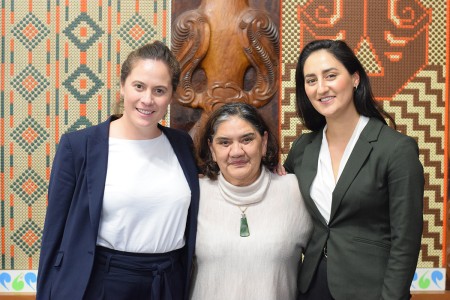
Dr Ella Henry pictured with her lawyers Natalie Coates (left) and Tara Hauraki (right)
Violet Walker (doc A66) documented a range of roles played by wāhine, especially concerning food and raising children. However, she emphasised balance with the roles of tāne, highlighting the mahi and skill wāhine provided. Her evidence also detailed how activities, such as tuna fishing, were performed.
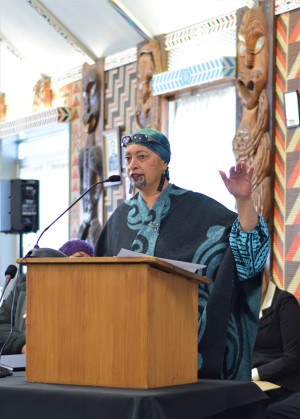
Violet Walker giving evidence at Terenga Parāoa Marae, Whangārei
Paihere Clarke (doc A141) emphasised the diversity of roles carried out by wāhine, stating that they ‘were landowners, had political roles, and had roles to do with our culture.’ She explained how these different roles helped establish and maintain balance between wāhine and tāne, who she said were of ‘equal status’. She also highlighted how wāhine could step into the roles of tāne but was unsure of whether tāne could do likewise.
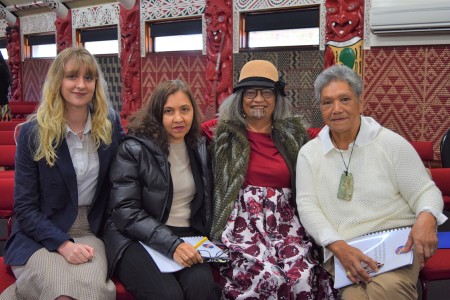
Paihere Clarke (in red) with lawyers Gretta Hansen and Janet Mason (left) and Jane Ruka (right)
Materangatira Lily Porter (doc A16(a)) (born 1936), a kuia from Te Urewera, said that there was a marked difference between tāne and wāhine in Tūhoe mātauranga and tikanga. She explained that this division was because the most important role of wāhine is ‘the creation and birth of tamariki Māori’. On the marae, this meant that Tūhoe wāhine could not whaikōrero: ‘When the men spoke on the paepae they stood out in front of the people, and in standing there, there is a potential for them to be attacked first. In this way, Tūhoe men protected the wāhine’. Instead, the role of wāhine was karanga. As such, while wāhine and tāne played distinct roles, they ‘do not act independently. They must work together’. Ms Porter also said that ‘most whānau like the male to be the rangatira’ but gave examples of kuia exercising influence in decision-making. Ms Porter said that both tāne and wāhine would share the work of kaitiakitanga.
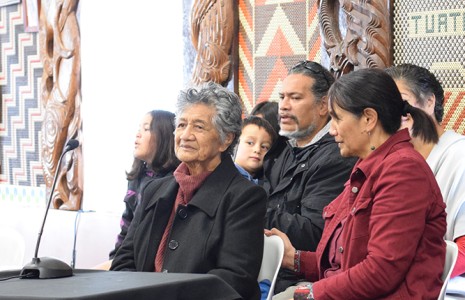
Materangatira Lily Porter giving evidence at Terenga Parāoa Marae, Whangārei, pictured with whānau
Te Atawhai Te Rangi (doc A120) emphasised that Māori worldviews acknowledge the interrelationship or whanaungatanga of all living things to one another and the environment, united by the principle of balance. It is only in this context, she argued, that the roles of wāhine and tāne in traditional Māori society can be understood. Both were essential parts of the collective whole, forming the whakapapa linking Māori people back to the beginning of the world, with women playing a key role here through te whare tangata. Collective social organisation meant women had flexibility to perform a wide range of roles, including leadership roles in military, spiritual, and political domains, as is reflected in kōrero tuku iho.
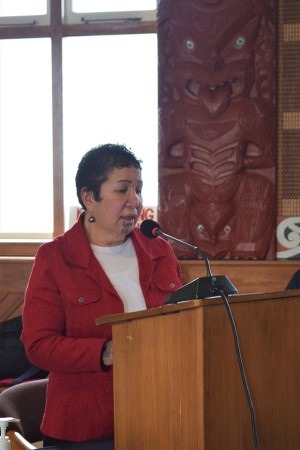
Te Atawhai Te Rangi giving evidence at Waiwhetū Marae, Lower Hutt
Rukuwai Allen (doc A74) presented deep reflections on the connections and symmetry between wāhine and tāne, drawing links to the spiritual domain of atua and the physical anatomy of men and women.
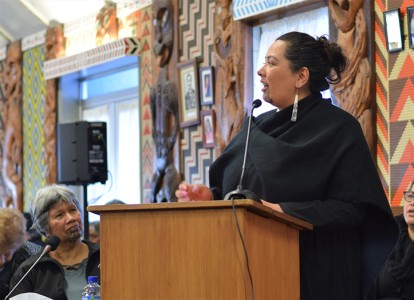
Rukuwai Allen giving evidence at Terenga Parāoa Marae, Whangārei
Whakataukī
- Traditionally, Ngai Tamahaua tikanga provided for the concept ‘he mana tō te tane, he mana anō tō te wāhine’. This promoted balance between men and women within all aspects of the Māori community to ensure all members of the hapū were allocated roles which complemented each other and enabled prosperity and survival of hapū, tikanga and whakapapa. (Kayreen Tapuke, doc A94, p 2)(external link)
- ‘He rerekē te mana o te wāhine, he rerekē te mana o te tāne’ – a whakataukī to emphasise that the authority of women is different to men. (Paula Ormsby, doc A55, p 17)(external link)
- The role of wahine was highly valued as was the role of tane. In fact, we all had our roles and each role had standing. Why? Because they were performed in contribution to the wellbeing of the community as a whole. That is the genesis of the well-known whakataukī, Ki mua, ki muri, from the front of house to the back everyone’s contribution is acknowledged as it is important to achieving the purpose on behalf of the whole marae. From the tuakana to the teina, wāhine to tāne, each had mana, even the pōtiki (youngest) has standing – the mana of being the pōtiki. (Sharryn Barton, doc A49, p 4)(external link)
- The saying ‘He kākano ahau i ruia mai i a Rangiātea’ has never referred only to male ‘seed.’ Rather it acknowledges that every mokopuna has the same origin and carry equivalent worthiness from that creation. (Dr Moana Jackson, doc A85, p 13)(external link)
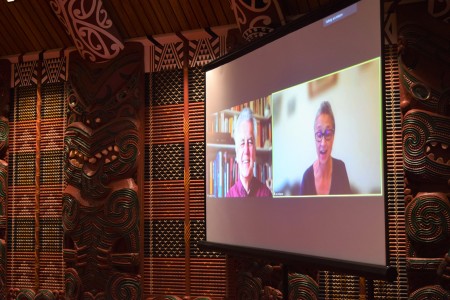
Dr Ani Mikaere reading the evidence of Dr Moana Jackson at Te Mānuka Tūtahi Marae, Whakatāne
What witnesses said
- “The job of wāhine is to bring the spiritual and physical domain together. This is in every aspect of tikanga, whether that be bringing a baby into the world, or bringing people onto a marae at a powhiri. It has always been the wāhine.” (Paihere Clarke, doc A141, p 7)(external link)
- “In terms of the relationship between wāhine and tāne in traditional Māori society, I believe that it is a myth that there was a clearly defined line between the roles and responsibilities of each gender. This is because the place of each within their society was understood by each person whether they were male or female. Essential practices, such as food gathering, were carried out as a shared whānau activity.” (Patricia Tauroa, doc A60, pp 9-10)(external link)
- “In the old traditional practice of hāhunga (preparation of a tūpapaku before interment of the remains), women would wash the remnants of flesh from the kōiwi and prepare the whāriki (flax mats) in which the kōiwi were wrapped. Men would carry and lay the kōiwi into the ana (burial caves). This basic division of roles continued into recent generations where women would wash the tūpapaku prior to it being transferred to the undertaker. Once placed into a coffin, the tūpapaku was then carried by men onto the marae, and then to the graveside. Graves were also dug by men. … This division of roles is for the protection of the whānau – of women and men. A tūpapaku is tapu, in the sense that the wairua of the tūpapaku is still very much a part of that person who has died. Wairua are not controlled by humans; the wairua protects the essence of the one who has died; it is this wairua that continues to ‘be’ in the realm of Hine nui te pō.” (Patricia Tauroa, doc A60, p 12)(external link)
- “First and foremost, wāhine Māori bore children and looked after them. They performed activities that are incidental to these responsibilities. They fed the children by conducting activities such as gathering kai, hunting game, and cooking it. Within a traditional Māori view of the world there was a balance of the roles between men and women. The responsibilities of child rearing and homemaking were equally shared with the men. One does not exist without the other.” (Violet Walker, doc A66, p 8)(external link)
- “Tāne were the hunters, gatherers, protectors, mouthpiece, and kaitiaki of the seed Te Kākano o Rangiatea. Wāhine were the Ahi Kaa, meaning they kept the village fires burning. Nurturing tamariki, Kairaranga, Kai Karanga, Kai Whatu Korowai, Katiaki o te Whare Tangata. The man and the woman were of equal status. In Waikato, no man is ever bigger than me just because he is tāne. Wāhine and tāne had equal roles. Wāhine were landowners, had political roles, and had roles to do with our culture. Both tāne and wāhine knew what their roles and responsibilities were. This knowledge of positionality established balance, and there was no swaying of it.” (Paihere Clarke, doc A141, p 3)(external link)
- “There were gendered roles, and the women could cross into the men’s roles, in terms of protecting our land and people. For example, when the tāne went out hunting, the wāhine were left to protect the pā. But I do not know if the men could cross into the women’s roles.” (Paihere Clarke, doc A141, pp 3-4)(external link)
- “I recall clearly my grandmother telling me: ‘We are not the same as men, why would we want to be, we are not men, but the way that our people do things is that men and women are equal. We have very different roles, but we are equal in everything we do. Wahine and Tane do not walk-in front of each other they walk together, and any decisions made are made together and as one.” (Deirdre Nehua, doc A25, p 5)(external link)
- “Traditionally, men would be responsible for more labour-intensive chores such as hunting. While Māori women would be responsible for activities such as collecting berries and preparing the food. As always, there are exceptions to rules, and of course women who were born of high rank would be exempt from such menial jobs. It was matauranga and tikanga that ensured the roles of both remain in their respective domains.” (Lee Harris, doc A23, p 3)(external link)
- “What is clear in Te Ao Māori is that wahine not only hold multiple roles but we seek ways through which to bring these together in ways that will benefit those around us and which uphold and enhance the aspirations of our people – past, present and future. A clear example is seen within the saying of Te Whiti o Rongomai following his arrest at Parihaka – ‘Tū Tama Wahine i te wā o te kore’ which calls upon all wāhine within Taranaki to take over all aspects of tikanga and living within Parihaka after the tāne of the Pā were removed.” (Leonie Pihama, doc A19, p 12)(external link)
- “The healthy survival of a hapu and whanau was dependent on men and women contributing to the collective need and wellbeing. Just as men contributed to raising children, men, and women-led parties into war, planted and harvested food, healed and nurtured, were decision-makers, and owners of their own property and assets.” (Barbara Ann Moke, doc A38, p 5)(external link)
- “Wāhine knew their specific role which complemented our Tane. It was based on the traditions of the kinship group. All able people worked. The children were cared for by both the kuia and kaumatua.” (Paula Ormsby, doc A55, p 17)(external link)
- “Within the papakainga men and women were equal. Each had a different but equal role to play in the advancement of the hapū for everyone worked to the same end, and everyone knew what was expected of them. Issues of gender equality did not arise and were seen as a Pākehā issue.” (Waina Hoete Ahipene, doc A37, p 1)(external link)
- “It was also considered unwise for women to carry out heavy labour as it is a woman’s responsibility to ensure that no harm would come to her that would prevent her ability to bear children. The prohibition of such was because it could bring harm to the woman and her whanau – the restriction was, therefore, a safeguard for all, not just for an individual.” (Patricia Tauroa, doc A60, pp 10-11)(external link)
- “Tērā hoki tētahi o ngā kōrero e mau ai te iho matua o te tangata, e kitea iho te mana o te wahine; 'Ka Tū a Rongo, ka Rongo a Tū'. He kōrero tēnei i takea mai ngā Whare Wānanga ō mua. Ko te tikanga o teneki kōrero e pā ana ki te tangata me ōna taha e rua, me kī; te taha tapu, me te taha noa – ka kīia ai; ko te taha tāne me te taha wahine. Me te mōhio iho, e kawea ana tērā āhuatanga e te tangata – Tāne mai, Wahine mai. Ko teneki kōrero, he kōrero ka ūhia atu, ka utaina atu ki runga ki ngā ākonga, ngā tauira rānei o te whare wānanga. Kia mātau ai rātou ki tērā tuāhua, ki tērā momo a te tangata. Ko tā te Māori kōrero – ko te tāne, ko te wahine, ka haere ngātahi. Ko Tū, ko Rongo, ka pērā anō." (Timitepō Hohepa, doc A90, pp 1-2)(external link)
"There is another phrase that encapsulates the mind of a person and unveils the mana of women; 'When Rongo stands (Tū), Tū listens (Rongo)'. This saying is derived from traditional Schools of Higher Learning. It relates to the duality of people; that is, the sacred and the secular dimensions – and also in reference to the male and female elements. We know that both Men and Women take on those very human responsibilities. This message was conveyed to the students of the Schools of Higher Learning so that they will understand that human characteristic and trait. Māori say that men and women must live in harmony, like Tū and Rongo." (Timitepō Hohepa, doc A90(a), p 1)(external link)
